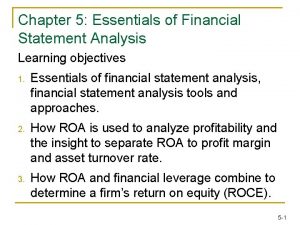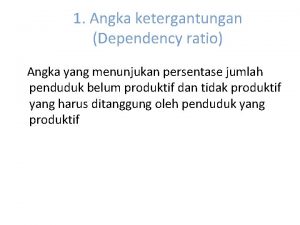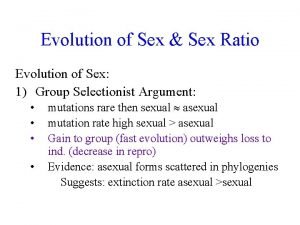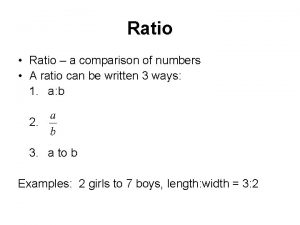Sex and Sex Ratio What is sex Why




















- Slides: 20

Sex and Sex Ratio • • What is sex? Why sex? Mechanisms of sex determination Sex ratio allocation

What is sex? Genetic recombination What determines gender?

Why Sex? The Costs. • Cost of males - could produce 2 times as many females • Cost of meiosis - favorable gene complexes recombine • Energetic and time costs of finding a mate

Why Sex? The Benefits. • Muller’s Ratchet – deleterious mutations accumulate in asexual lineages • Genetic Recombination – novel gene combinations are created – Red Queen Hypothesis: need to create new gene arrangements to combat pathogen evolution

Evolutionary Arms Race • Some spp of snails are both sexual and asexual • Sexual proportion (freq. of males) increases with parasite infection

Sex determination • Influences the degree to which a female can alter the sex ratio of her offspring • Types – Chromosomal – Environmental – Social

Chromosomal Sex Determination • Heterogamety – Male: (XY) mammals, flies – Female: (ZW) Birds, Butterflies

Chromosomal Sex Determination • Haplodiploidy: all hymenoptera, thrips, scale insects, some beetles – Haploid males develop from unfertilized eggs – Diploid females develop from fertilized eggs Creates asymmetries in relatedness

Environmental Sex Determination • Incubation temperature – Terrapins – Turtles – Alligators

Social Sex Determination • Some fish undergo sex reversal • Depends on mating system • Ex: dominant female in sea bass harem changes into male when territorial male disappears

Sex Ratio Allocation: Null Model • R. A. Fisher: Parental strategies should evolve towards equal investment in offspring of the two sexes • If sex ratio falls below 50%, increased production of rare sex is favored • Assuming random mating, rare sex will experience greater reproductive success • Frequency-dependent selection leads to an ESS of 1: 1 sex ratio

Adaptive Sex Ratio Bias • Maternal condition influences offspring investment (Trivers-Willard Effect) 2. Local mate competition 3. Local resource competition 4. Local resource enhancement

Trivers-Willard Effect • Population sex ratio is 1: 1, but individual sex allocation depends on condition • If moms in good condition transfer competitive ability to sons more than daughters • Then, they should produce more sons than daughters assuming that • Dominant individuals sire more offspring

Condition-dependent sex allocation in red deer

Dominance dependent sex allocation in yellow baboons • Dominant females have more daughters than sons (pass social rank to daughters)

Local Mate Competition • Mating b/w siblings takes place near hatching site • Males compete with each other for matings. • Solution: Produce few sons. Expect most offspring of first-laying female to be daughters • What if a second female arrives to lay eggs? • Ex: Nasonia wasps; haplodiploid ‘superparasites’ on fly pupae

Depends on proportion of eggs that belong to the second female

Local Resource Competition • Offspring that stay near their birth site may compete with their parents for resources • In many species, one sex disperses farther or at a greater rate than the other sex • Solution: Produce more of the dispersing sex (Ex: galagos produce more males)

Local Resource Enhancement • In some spp. , offspring of one sex delay dispersal and remain at the natal site to help parents raise their siblings • Benefits of helpers must be greater than cost of increased competition • Ex: Red-cockaded woodpecker male-biased • Prediction: Sex-ratio biased towards helping sex on high-quality territories?

Seychelles Warblers As territories fill up, produce fewer males (which disperse) but more females (which help)
 Kurt bumby
Kurt bumby Sex sex sex
Sex sex sex Xxtesticles
Xxtesticles Sex sex sex
Sex sex sex Secondary sexual characters
Secondary sexual characters Pictures
Pictures Punnett square for sex linked traits
Punnett square for sex linked traits Sex linkage
Sex linkage Sex determination and sex linkage
Sex determination and sex linkage Dont ask why why why
Dont ask why why why Acid test ratio and quick ratio
Acid test ratio and quick ratio Phenotypic ratio in dihybrid cross
Phenotypic ratio in dihybrid cross Current ratio and quick ratio
Current ratio and quick ratio Once a sex offender always a sex offender
Once a sex offender always a sex offender Rumus insiden kumulatif
Rumus insiden kumulatif Rumus rasio jenis kelamin
Rumus rasio jenis kelamin Persebaran penduduk
Persebaran penduduk Dependency ratio definition ap human geography
Dependency ratio definition ap human geography Rumus sex ratio
Rumus sex ratio Dependency ratio merupakan angka yang menunjukkan
Dependency ratio merupakan angka yang menunjukkan Cara menghitung angka ketergantungan
Cara menghitung angka ketergantungan





































